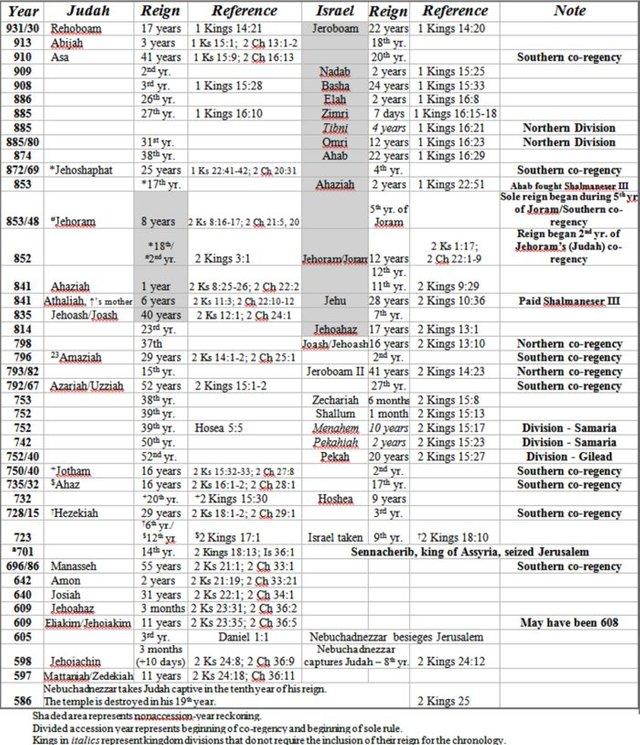Chronology of the Kings of Israel and Judah - Part 5 - Workable, but Challenged
Up to this point we've mostly set the playing field and put our pieces in place. We've done some minor tweaking to the first overview, and now we're going to start really refining it. Some scholars, such as Leslie McFall, have studied this topic so intensively that they've proposed seasons for specific accessions and co-regencies. Our purpose here, however, is not to narrow down our precision so much as show a good working possibility.
A Workable Overview
There is secular historical data to back up the dates of both the fall of Samaria and the fall of Judah. According to a Babylonian chronicle written in the 22nd year of King Darius (500/499 B.C.), Shalmaneser V died in the tenth month of the fifth year of his reign, 722. It is noted that he destroyed the city of Shamarain, which is likely Samaria. This substantiates a date of 723/22 for the fall of Samaria. Also worth mention are the annals of Sennacherib which describe a siege of Jerusalem in the record of his “third campaign.” This may have been the siege of 701 recorded in 2 Kings 18:13 and Isaiah 36:1, which took place in the 14th year of Hezekiah’s reign.[1]

British Museum Tablet No. 21946 and Jeremiah (46:2) discuss the battle of Carchemish. The tablet places it immediately preceding the death of Nabopolassar, which appears to be 605. This correlates with Jeremiah’s record that the battle of Carchemish took place in the fourth year of Jehoiakim’s reign, which would have been 605 as well. In addition Jeremiah 25:1 identifies the fourth year of Jehoiakim’s reign with the first year of Nebuchadnezzar.
It must be noted that these dates are somewhat debatable. Some would place the date of Nebuchadnezzar’s ascension in 604/603. However, because of the differing calendars and accession systems involved, though this detail bears more research, for the purpose of this work the date of 605, or perhaps 605/604, is acceptable.
Further evidence reveals that Nebuchadnezzar suffered a defeat on the borders of Egypt during his fourth year, 601. This event probably spurred Jehoiakim to rebel against him in his eighth year, a rebellion recorded as following three years of servitude in 2 Kings 24:1. This would place the rebellion in about 601/600.[2] More information is available, however, this gives us enough information to be reasonably sure of our dates regarding the fall of Israel and Judah.

A Significant Challenge
At this point it would be wonderful to say that we have everything figured out; however, there are three glaring inconsistencies in our calculations. One is found in 2 Kings 17:1 where Hoshea is said to become king of Israel in the 12th year of Ahaz. This appears to be impossible in light of the chronology we have before us, which places Ahaz’ ascension in 735 and Hoshea’s in 732.
Another challenge is found in 2 Kings 18:10 where we read that Samaria was besieged in the fourth and taken in the sixth year of Hezekiah. Again, this appears impossible in light of the record we have before us. Israel was taken in 723, however Hezekiah’s reign didn’t start until 715. Thiele ascribes these differences to scribal or copyist efforts to attempt to synchronize the texts.[3] Finally we have a related discrepancy that says the Hezekiah’s succession was in the 3rd year of Hoshea’s reign, which would be 729, 14 years earlier than the date we have of 715.
Although this obstacle seems daunting, there is an explanation. At this point in our research it is difficult to keep from considering the possibility, or even probability, of a scribal/copyist error, or misjudgment. The date that is the lynch pin in this challenge is the date of Sennacherib’s siege of Jerusalem in its relationship with Hezekiah’s reign. According to both Isaiah 36:1 and 2 Kings 18:13 this siege took place in the 14th year of Hezekiah. Considering that the date of this siege is verifiably in 701, we are forced to place Hezekiah’s succession in 715. However, Archer presents an argument that must be seriously considered:
If the type of numerical notation was used in the Vorlage which appears in the Elephantine Papyri, it would require only the smudging of one horizontal stroke to make a twenty-four look like a fourteen. Or if the numbers were spelled out, then it would take only the misreading of one letter (mēm miscopied as hē) to convert “twenty-four” (˒arba˓ ˓ešrɩ̂m) into “fourteen” (˒arba˓ ˓ešrēh) according to the earlier orthography. In support of this emendation is the instance of 2 Chron. 36:9, which gives the age of Jehoiachin as eight when he ascended to the throne; whereas 2 Kings 24:8 indicates that he was actually eighteen. Here again we have a type of manuscript error which involves a second-place digit. Even Thiele readily acknowledges that 2 Chron. 36:9 contained such an error, and that eight should be corrected to eighteen. Quite possibly the scribal error originated in a Vorlage of Isa. 36:1, which contained the mistaken fourteen instead of twenty-four, and had no other chronological check points in context to ensure the accuracy of this numeral. The scribe who copied out 2 Kings 18:13 may have deferred to this statement in Isaiah, remembering that this was what the prophet apparently recorded. Another such example is found in 2 Chron. 2:2, which gives the age of Ahaziah ben Jehoram as forty-two when he began to reign, whereas 2 Kings 8:26 gives it as twenty-two.[4]
If Archer’s presentation is correct, then some of our challenges are cleared up, but others arise. If Hezekiah was crowned in 725 and reigned 29 years, this allows for Manasseh to succeed him without a co-regency. Instead, Hezekiah would have been co-regent with Ahaz from 725 until 716. This clears up the difference between Sennacherib’s siege of Jerusalem and Hezekiah’s ascension. However, it does not deal with the record of Israel being taken in Hezekiah’s sixth year (we have only 2 years), nor does it account for Hezekiah assuming the throne in the third year of Hoshea, there being six years between them.
Archer does suggest that the stronger textual evidence places Hezekiah’s succession in 728, which would take care of these last two challenges, but leaves us with more than 24 years between Sennacherib’s siege and Hezekiah’s ascension, and still doesn’t account for Hoshea’s ascension in the 12th year of Ahaz.
At this point we have pulled together the data to give us a plausible timeline, but it still leaves us with quite a bit of tension. Tomorrow we'll conclude this study as we focus on this tension more fully, and offer a solution that not only answers these questions, but actually brings the timeline together even better as a result. This will be followed by some reflection as well as a bibliography.
Steemin' on,
Another Joe

Email notifications
AJ Facebook
AJ Twitter
[1] Jack Finegan, Handbook of Biblical Chronology (Princeton, N.J.: Princeton University Press, 1964), 197-98.
[2] Finegan, Handbook, 200 ff.
[3] Thiele, Chronology, 137.
[4] Gleason Leonard Archer Jr., A Survey of Old Testament Introduction, 3rd ed. (Chicago: Moody Press, 1994), 321.

~ Introduction - Part 1 - Part 2 - Part 3 - Part 4 ~


Following Joe! :D
Thanks!!
Hey, I got the image at the bottom to work. It was too large. I didn't know that was possible, but when I downsized it, it showed up. Yay! :)
Now I just need one of those flying pulpits so I can go check out some of these places for myself.... if I can avoid getting shot down!
I gotta admit, they dropped the ball not green-lighting those things! Woulda been awesome. :D